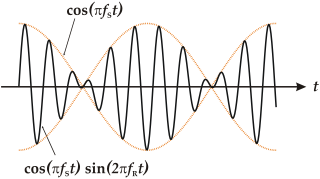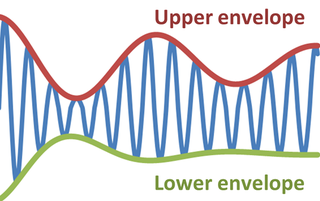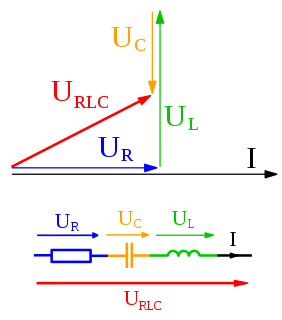 W
WIn physics, interference is a phenomenon in which two waves superpose to form a resultant wave of greater, lower, or the same amplitude. Constructive and destructive interference result from the interaction of waves that are correlated or coherent with each other, either because they come from the same source or because they have the same or nearly the same frequency. Interference effects can be observed with all types of waves, for example, light, radio, acoustic, surface water waves, gravity waves, or matter waves. The resulting images or graphs are called interferograms.
 W
WA backhoe — also called rear actor or back actor — is a type of excavating equipment, or digger, consisting of a digging bucket on the end of a two-part articulated arm. It is typically mounted on the back of a tractor or front loader, the latter forming a "backhoe loader". The section of the arm closest to the vehicle is known as the boom, while the section that carries the bucket is known as the dipper, both terms derived from steam shovels. The boom is generally attached to the vehicle through a pivot known as the king-post, which allows the arm to pivot left and right, usually through a total of 180 to 200 degrees.
 W
WBarrier-grid animation or picket-fence animation is an animation effect created by moving a striped transparent overlay across an interlaced image. The barrier-grid technique originated in the late 1890s, overlapping with the development of parallax stereography (Relièphographie) for 3D autostereograms. The technique has also been used for color-changing pictures, but to a much lesser extent.
 W
WIn acoustics, a beat is an interference pattern between two sounds of slightly different frequencies, perceived as a periodic variation in volume whose rate is the difference of the two frequencies.
 W
WA bulbous bow is a protruding bulb at the bow of a ship just below the waterline. The bulb modifies the way the water flows around the hull, reducing drag and thus increasing speed, range, fuel efficiency, and stability. Large ships with bulbous bows generally have twelve to fifteen percent better fuel efficiency than similar vessels without them. A bulbous bow also increases the buoyancy of the forward part and hence reduces the pitching of the ship to a small degree.
 W
WIn physics, dynamic speckle is a result of the temporal evolution of a speckle pattern where variations in the scattering elements responsible for the formation of the interference pattern in the static situation produce the changes that are seen in the speckle pattern, where its grains change their intensity as well as their shape along time. One easy to observe example is milk: place some milk in a teaspoon and observe the surface in direct sunlight. There will be a visible "dancing" pattern of coloured points. Where the milk dries on the spoon at the edge, the speckle is seen to be static. This is direct evidence of the thermal motion of atoms, which cause the Brownian motion of the colloidal particles in the milk, which in turn results in the dynamic speckle visible to the naked eye.
 W
WIn physics and engineering, the envelope of an oscillating signal is a smooth curve outlining its extremes. The envelope thus generalizes the concept of a constant amplitude into an instantaneous amplitude. The figure illustrates a modulated sine wave varying between an upper and a lower envelope. The envelope function may be a function of time, space, angle, or indeed of any variable.
 W
WIn interferometry experiments such as the Michelson–Morley experiment, a fringe shift is the behavior of a pattern of “fringes” when the phase relationship between the component sources change.
 W
WAn interference filter or dichroic filter is an optical filter that reflects one or more spectral bands or lines and transmits others, while maintaining a nearly zero coefficient of absorption for all wavelengths of interest. An interference filter may be high-pass, low-pass, bandpass, or band-rejection.
 W
WIn mathematics, physics, and art, moiré patterns or moiré fringes are large-scale interference patterns that can be produced when an opaque ruled pattern with transparent gaps is overlaid on another similar pattern. For the moiré interference pattern to appear, the two patterns must not be completely identical, but rather displaced, rotated, or have slightly different pitch.
 W
WIn physics and engineering, a phasor, is a complex number representing a sinusoidal function whose amplitude (A), angular frequency (ω), and initial phase (θ) are time-invariant. It is related to a more general concept called analytic representation, which decomposes a sinusoid into the product of a complex constant and a factor that encapsulates the frequency and time dependence. The complex constant, which encapsulates amplitude and phase dependence, is known as phasor, complex amplitude, and sinor or even complexor.
 W
WQuetelet rings are a type of optical interference pattern occurring at an illuminated reflective surface covered by fine particles, such as a dusty mirror. It is named after the astronomer Adolphe Quetelet, who observed the phenomenon and explained its formation. A slight variation of the setup is sometimes referred to as Newton's dusty mirror experiment, since Isaac Newton had already discovered the phenomenon by the end of 17th century, but did not interpret or explain it.